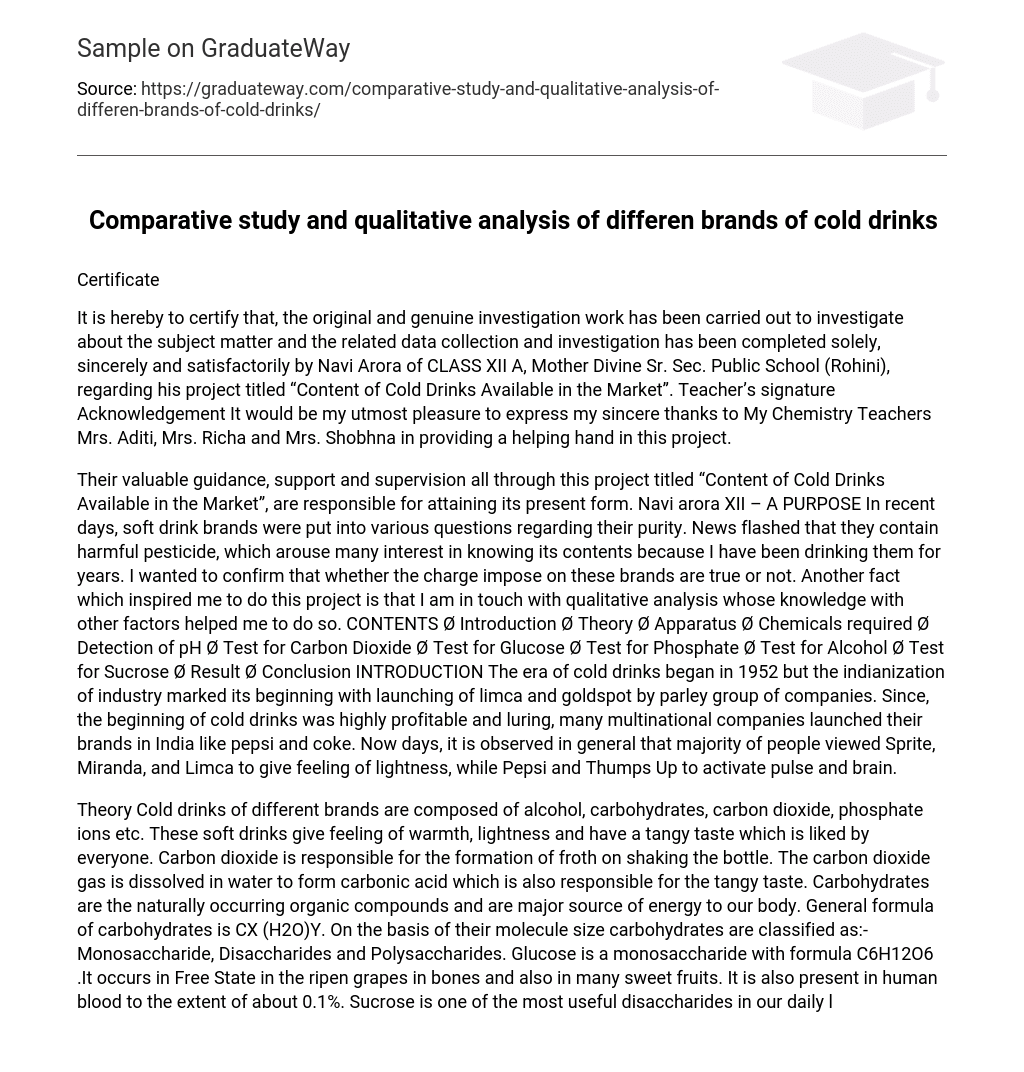Certificate
It is confirmed that Navi Arora of CLASS XII A, Mother Divine Sr. Sec. Public School (Rohini), has conducted an original and authentic investigation regarding the subject matter and related data collection for the project titled “Content of Cold Drinks Available in the Market”. The investigation has been completed solely, sincerely, and satisfactorily. The teacher’s signature is provided as acknowledgement. I would like to sincerely thank my Chemistry Teachers – Mrs. Aditi, Mrs. Richa, and Mrs. Shobhna – for their assistance in this project.
The valuable guidance, support, and supervision throughout the project titled “Content of Cold Drinks Available in the Market” have contributed to its current form. Navi Arora XII – A PURPOSE In recent days, soft drink brands have been questioned about their purity. News has circulated that they contain harmful pesticide, which has sparked interest in learning about their contents as I have been consuming them for years. I wanted to verify whether the accusations against these brands are true or not. Another motivating factor for this project is my familiarity with qualitative analysis and its knowledge of other factors.
CONTENTS
- Introduction
- Theory
- Apparatus
- Chemicals required
- Detection of pH
- Test for Carbon Dioxide
- Test for Glucose
- Test for Phosphate/li>
The era of cold drinks began in 1952, but it was the Indianization of the industry that marked its beginning with the launch of Limca and Goldspot by the Parley Group of Companies. Since then, the popularity of cold drinks has attracted many multinational companies to launch their brands in India, such as Pepsi and Coke. Nowadays, it is commonly observed that Sprite, Miranda, and Limca are associated with a feeling of lightness while Pepsi and Thumps Up are known to activate one’s pulse and brain.
Theory Cold drinks, encompassing different brands, typically contain alcohol, carbohydrates, carbon dioxide, and phosphate ions. These beverages are known for their warming effect, lightness, and universally enjoyed tangy flavor. Shaking the bottle causes froth formation due to the presence of carbon dioxide. This gas dissolves in water to create carbonic acid, contributing to the tangy taste. Carbohydrates are natural organic compounds that provide energy for our bodies. The general formula for carbohydrates is CX (H2O)Y. Based on molecular size, carbohydrates can be classified as monosaccharides (e.g., glucose), disaccharides (such as sucrose), and polysaccharides.
Glucose can be found in ripe grapes, bones, sweet fruits; it also exists in human blood at an approximate concentration of 0.1%. Sucrose is a widely used disaccharide present in juices, seeds, and flowers of various plants. Sugar cane juice contains around 15-20% sucrose while sugar beet has about 10-17%. The molecular formula for sucrose is C12H22O11 which forms from a combination of glucose and fructose. Unlike glucose’s properties as a reducing agent, sucrose does not possess such capabilities.
Cold drinks generally have a slightly acidic nature with acidity levels determined by measuring pH value.
Soft drinks have a negative impact on our health for several reasons. Firstly, their high sugar content can potentially lead to diabetes. In addition, these beverages disrupt the body’s natural hunger suppression mechanisms and may contribute to weight gain. Furthermore, soft drinks contain properties that can dissolve calcium, which poses a threat to our bones.
It is important to note that soft drinks also contain phosphoric acid with a pH level of 2.8. This low acidity allows them to dissolve a nail within approximately four days. As a result, commercial trucks transporting soft drink syrup must display hazardous material placards for highly corrosive substances.
Another concerning aspect of soft drinks is their ability to deplete blood, further emphasizing their negative impact on our overall well-being.
Uses of Cold Drinks
Cold drinks have multiple uses when it comes to cleaning. They can effectively eliminate rust spots on chrome car bumpers and corrosion on car battery terminals. Additionally, soft drinks serve as an exceptional “detergent” for getting rid of grease stains on clothes.
They have the ability to loosen a bolt that has rusted.
<





